The bustling city of Melbourne has been host to the Australian Grand Prix since 1996. On all but two of those occasions, the Albert Park track has hosted the season-opening race. Take a trip down memory lane as we look back at Melbourne’s most memorable F1 moments!
BACK-TO-BACK FOR BUTTON
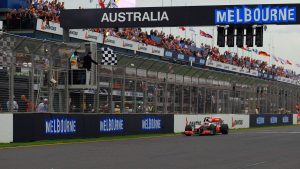
Jenson Button was always a star performer in changeable conditions, as he proved in the 2010 Australian Grand Prix. Despite tapping the Ferrari of Fernando Alonso at the first turn and spinning the Spaniard to the back of the pack, Button was dealing with the damp track well at the start of the race. He was the first driver to switch to slick tyres, but found himself sliding off the still-damp track. Nevertheless, he had made the call correctly as everyone else soon joined him on the dry tyres. After Sebastian Vettel’s race ended in a gravel trap, Button became the race leader and went on to become the first driver to win back-to-back races at Albert Park with two different teams. It was also his first victory with the McLaren team.
A THRILLING 2008 SEASON OPENER
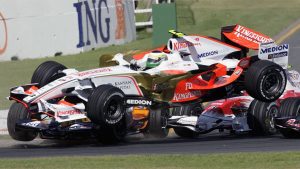
It was a chaotic race in 2008, where only seven cars made the finish. After Felipe Massa spun out at Turn 1, Giancarlo Fisichella was taken out by Nelson Piquet Jnr soon after. At Turn 3, Mark Webber, Anthony Davidson, Jenson Button and Sebastian Vettel all crashed and were eliminated from the race. Felipe Massa and David Coulthard then collided on Lap 26, before Timo Glock had the biggest crash of the day, running wide and breaking his suspension. One of the drivers who finished – Rubens Barrichello – was disqualified after the race, as he left the pit-lane when the red light was showing. Barrichello had pitted and took the still attached fuel hose with him after his stop, resulting in minor injuries to his pit crew. Robert Kubica and Kazuki Nakajima added to the list of crashes as they collided. Ferrari had a dire day as both of their engines failed. Despite all of this happening, Lewis Hamilton remained calm at the front throughout the race and opened his 2008 season in the best possible way.
SURPRISE RESULTS
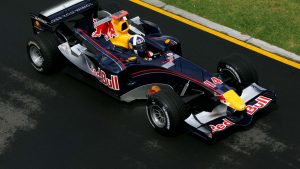
There have been a few surprises in Melbourne over the years. In 2005 Red Bull turned up for their first race and surprised the paddock when Vitantonio Liuzzi, in his first F1 appearance, set the fastest time by over half a second in the First Practice session. After a mixed up qualifying, Red Bull managed to set times good enough for fifth and sixth and both drivers scored points on the Sunday – with David Coulthard finishing a fantastic fourth and Christian Klien finishing seventh. The team scored more points in one race than Jaguar did in the whole of the 2004 season.
There were celebrations for the small Super Aguri team in 2007 as Takuma Sato reached Q3 with the team for the first time.
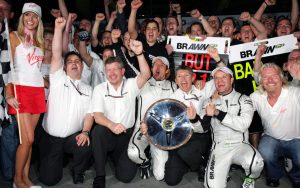
Perhaps the most notorious surprise result in the history of the sport came here in 2009, on the début for the Brawn GP team. After Honda withdrew from F1 at the end of the 2008 season, the future for the team looked bleak. But, as Ross Brawn took the helm, the team turned around their fortunes and set impressive times in testing. It proved the times were no fluke, and they dominated the opening race weekend of the season, with Jenson Button taking pole and winning the Grand Prix. Rubens Barrichello consolidated the result. After a tricky race for the Brazilian, he found himself back up to second by the end of the Grand Prix. This marked the first time a team had won on début since Mercedes in 1954.
BIG CRASHES
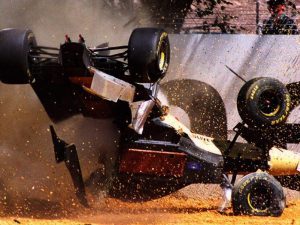
There have been a number of hefty shunts throughout F1’s tenure in Melbourne. The first came just seconds into the first Grand Prix here in 1996, as Martin Brundle’s Jordan mounted the back of David Coulthard’s McLaren, sending the Jordan driver airbourne in a frightful crash. Remarkably, Brundle was not only able to make it out of the wreckage, but he also made the restart of the race in the team’s spare car. Twenty years after Brundle’s crash at Turn 3, Fernando Alonso suffered a similar fate as he careered into the back of Esteban Gutierrez’s Haas. The Spaniard’s resulting injuries saw him sit out the next Grand Prix.
2002 produced some epic images as Ralf Schumacher flew over the top of Rubens Barrichello’s Ferrari at the first turn on the first lap. The ensuing carnage led to eight drivers in total being eliminated from the race. 2010 also produced stunning images, as a front wing failure on Kamui Kobayashi’s Sauber caused him to T-bone Nico Hulkenberg’s Williams.

There was a close call in 2007, as David Coulthard and Alex Wurz crashed on Lap 48, with Coulthard’s Red Bull flying over the cockpit of the Williams and narrowly missing Wurz’s head.
In 2001, the marshal Graham Beveridge was killed following a crash between Jacques Villeneuve and Ralf Schumacher. On the sombre day, there was no champagne on the podium as a mark of respect.
ONE TO FORGET
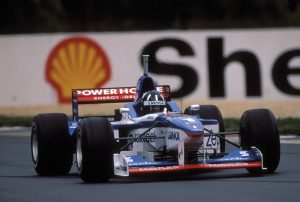
Despite being the reigning World Champion, Damon Hill was booted out of the Williams clique at the end of the 1996 season, and found himself driving for Arrows in 1997. After media speculation that Hill had quit the team the week before the season-opening Australian Grand Prix due to how slow the car was, the British driver suffered a jammed throttle on the parade lap on his first race for the team, which immediately put him out of the race. Also in 1997, Jean Alesi embarrassingly retired from the race after running out of fuel, despite the Benetton team repeatedly calling him into the pits five laps earlier.
1999 was one to forget for Michael Schumacher. After a start line crash, the race was red-flagged. Schumacher then had issues from third on the grid, and stalled before the new formation lap. As a result, he was forced to start from the back. When the race got going, he had a puncture and then later in the race, amid some confusion, he drove through the pits without making a stop, before having his steering wheel replaced on the next lap. Ultimately, the German finished eighth – a lap down on his team-mate who won the Grand Prix.
It wasn’t just Schumacher who struggled in 1999. McLaren dominated the practice and qualifying sessions but while the car was fast, it was far from reliable, and both Mika Hakkinen and David Coulthard retired in the early stages of the race. Then in 2000, for the second year in a row, both McLaren drivers retired from the Grand Prix after both lining up on the front row of the grid.
Despite not finishing the 2002 Grand Prix, both Arrows were disqualified for separate reasons. Heinz-Harald Frentzen was disqualified for leaving the pit-lane under a red light, while Enrique Bernoldi was disqualified for switching to the team’s spare car after the race had started.
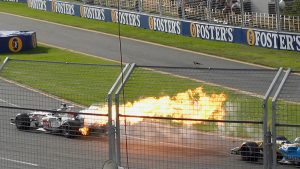
Jenson Button’s engine blew two corners before the end of the race here in 2006. He purposefully came to a halt just metres before the finish line, frustratingly missing out on points, but saving himself from a ten-place grid penalty at the next race.
After scoring the first point of his F1 career in the 2006 Australian Grand Prix, Scott Speed later had it taken off him due to overtaking under yellow flags. The American was furious, and was fined $5000 for swearing at David Coulthard, who’d inherited his eighth place finish, in a post-race hearing.
For two successive years in 2011 and 2012, HRT were refused entry into the Grand Prix after failing to set a time within 107% of the polesitter’s time.
Rio Haryanto’s F1 career didn’t get off to the best start here in 2016 when he clattered into the side of Romain Grosjean’s Haas in the pit-lane at the start of the final practice session. The Indonesian driver was given a three-place grid penalty for the incident.
The Albert Park track certainly doesn’t have happy memories for Pastor Maldonado. In five attempts, he never finished an Australian Grand Prix.
HOME HEROES
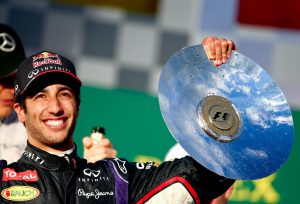
An Australian driver has never finished on the podium at their home event. It wasn’t until 2002 that an Australian driver raced in F1 at the Albert Park track. Mark Webber received massive support on his F1 début for the back-marker Minardi team. The Australian finished in a magnificent, and unexpected, fifth place. Webber and the team celebrated in front of the fans on the podium after the official proceedings. 2012 was the only time when Webber bettered this result at his home race. He finished fourth. 2012 was also the first time where the Australian Grand Prix featured two Australians on the grid. Daniel Ricciardo, who joined Toro Rosso for the 2012 season, would step up and take Webber’s place at the Red Bull team for 2014. After impressively qualifying on the front row on his début for the team, the Australian went on to finish second but was later disqualified for a technical infringement.
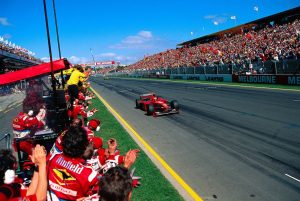
IRVINE TAKES HIS FIRST WIN
Only one driver has celebrated their maiden victory here. That was Eddie Irvine in the 1999 event. The Ulsterman took full advantage of both his team-mate’s problems and the retirements of both McLaren cars to take the first of his four Formula One victories. The other three victories all came in the same season, as Ferrari placed all their faith in Irvine following Schumacher’s heavy accident at Silverstone which saw him break his legs and sit out most of the season. The Irish driver eventually finished runner-up in the championship to Mika Hakkinen.
A SMALL GRID
In 2015, the grid was down to eighteen cars due to Manor Marussia being unable to start the season on time. The team had been in administration, but were saved by investors. However, the delay meant they had done no testing and failed to appear in the practice sessions. The grid dropped to seventeen cars as Valtteri Bottas injured his back after running over a kerb in qualifying and was forced to sit out the race. The field was then made smaller by Kevin Magnussen who missed the start as his engine failed on the way to the grid. Finally, Daniil Kvyat’s Red Bull came to a halt as the grid formed, causing an extra formation lap. In the end, only fifteen cars started the race.
ELIMINATION QUALIFYING
For the 2016 event, the qualifying system was changed in order to make Saturdays more exciting. – It didn’t go down well. The elimination style sessions meant that the result was decided long before the end of the session, with all the cars back in their garages before the chequered flag fell.
In 2013, Qualifying for the Australian Grand Prix had to be abandoned following heavy rainfall. The Q2 and Q3 sessions were rescheduled for the Sunday morning before the Grand Prix.
SENSATIONAL DEBUT PODIUMS
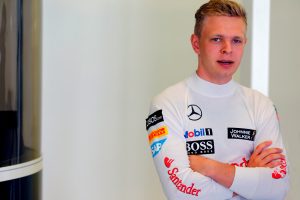
Three drivers have finished on the podium in their debut Grand Prix at this track. In 1996, Jacques Villeneuve’s career got off to an impressive start as he took pole in the Williams. The Canadian dominated the race until engine issues slowed him down, allowing his team-mate Damon Hill to take the first victory of the season. In 2007, Lewis Hamilton put on an equally impressive show to finish third on his debut for the McLaren team. He memorably overtook his team-mate Fernando Alonso on the run to the first turn. Most recently, Kevin Magnussen finished as the runner-up on his F1 début – which was also the first (and only so far) F1 podium for a Danish driver. The Dane had a scary start to the race as his car veered off to the left of the track due to a large amount of torque.
FINAL TOP STEP APPEARANCES
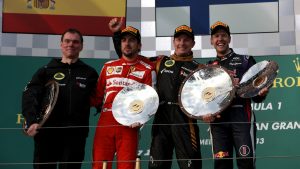
The Australian Grand Prix has also seen the final victories and podiums for some F1 drivers. In 2003, David Coulthard took his last F1 victory. Juan Pablo Montoya had a comfortable 2.7 second lead until eight laps from the end, when he spun at the first corner and lost the lead to Coulthard’s McLaren. Coulthard had started the race from eleventh – the lowest grid slot from which a race at Albert Park has been won. 2006 saw Ralf Schumacher’s last F1 podium, and Toyota’s only podium appearance in 2006. He took the podium despite receiving a drive-through penalty for speeding in the pit-lane. Kimi Raikkonen took his last F1 win to date here in 2013. It also transpired to be the last win for the Lotus name, and for the Enstone team as of the start of the 2018 season. The 2014 Australian Grand Prix was also Jenson Button’s 50th and final F1 podium, though he never actually stood on it. The result, which saw McLaren finish in second and third, was the last time the Woking-based team finished in the top three.
POINTS ON DEBUT
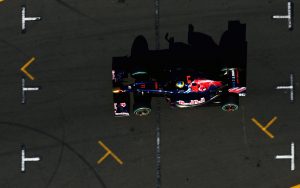
Many drivers have made their débuts at this track, with the most impressive bows coming from the already discussed Jacques Villeneuve, Lewis Hamilton and Kevin Magnussen. Beyond them, three Toro Rosso drivers – Sebastien Buemi, Daniil Kvyat and Carlos Sainz – scored points on their maiden appearance. At the 2009 Australian Grand Prix, Buemi became the first Swiss driver since 1985 to score a point in F1. When Kvyat finished ninth in the 2014 Australian Grand Prix he became the youngest driver to score points in F1 – a record which was later beaten by Max Verstappen. Sebastien Bourdais could have joined the list of Toro Rosso drivers to score on début, if not for an engine failure just three laps from the chequered flag.
Plenty of teams have made their débuts here too. While Brawn GP won on their first race appearance, Toyota, Red Bull and Haas have been the other teams to score in their maiden races at this track.
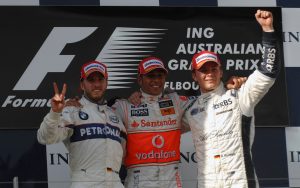
There have been other firsts here too. In 2007, Kimi Raikkonen won his first race with Ferrari on his maiden outing with the Italian team. Nico Rosberg took the first podium finish of his career at this track in 2008 for Williams. In 2011, Vitaly Petrov scored his only F1 podium finish. It was also the first time a Russian driver had finished in the top three. In 2015, Marcus Ericsson scored the first points of his career. From that weekend, Sauber scored 14 points, compared to their 0 in the entire previous season, and were placed third in the championship. In the same event, Sebastian Vettel made his début for Ferrari and finished on the podium for the first time in red.
MELBOURNE CONTROVERSIES
In 1998, Mika Hakkinen controversially won the Australian Grand Prix after David Coulthard let him by a few laps before the end of the race. Hakkinen had come in to the pits on Lap 36 after ‘mishearing’ a radio call. In 2007, Ron Dennis claimed that someone had tapped into the team’s radio system. Hakkinen and Coulthard had agreed that whichever driver was ahead at Turn 1 on the first lap would be the winner of the race. Coulthard was criticised for following through with the deal, and the case was taken to the World Motorsport Council. They didn’t punish the team, but said that any future similar events would be heavily penalised. This was also the closest finish in Australian Grand Prix history, but the McLaren cars had lapped the entire field.
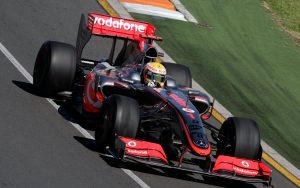
Running outside of the points at the end of the 2005 Australian Grand Prix, BAR brought both of their cars into the pits at the end of the last lap. By not officially finishing the Grand Prix, they exempted themselves from a new two-race engine rule. At the next race, the team could fit new engines without incurring a penalty. The loophole in the rules was closed after the incident.
In 2009, Lewis Hamilton was disqualified from the race for misleading the race stewards. Hamilton had started eighteenth, but made his way up the order throughout the race, eventually ending up in fourth. Jarno Trulli went off the track under Safety Car conditions towards the end of the race, and Hamilton overtook him, as he was entitled to. However, the McLaren team had told the Brit to let Jarno Trulli repass him when the Toyota driver rejoined the track – something which Hamilton denied even after being played an audio recording of the message in a stewards meeting at the Malaysian Grand Prix. Dave Ryan was subsequently sacked from the team for his involvement in the incident.
THE SAUBER MERRY-GO-ROUND
The 2015 running of the Australian Grand Prix is perhaps most memorable for Sauber’s off-track antics, where they’d reportedly signed more drivers than they had cars. Geido van der Garde took legal action and Sauber were forced to miss the First Practice session as a result.
DID YOU KNOW?
- Since their return to the sport in 2010, the 2011 Australian Grand Prix was the first time Mercedes suffered a double DNF. It’s also the only time, aside from the 2016 Spanish Grand Prix, that this has happened since. Michael Schumacher retired as a result of a puncture from a collision with Jaime Alguersuari, while Nico Rosberg’s car was damaged when Rubens Barrichello hit his sidepod.
- The first race here in 1996 was the first F1 Grand Prix to use the five red light system to signal the beginning of the race.
- David Coulthard’s win for McLaren-Mercedes in Melbourne in 1997 was the first time a Mercedes powered car had won a Grand Prix since 1955.
- The 1998 Australian Grand Prix, won by Mika Hakkinen, was the first F1 race to be won by a car using Bridgestone tyres. It was also the first non-Goodyear win since the 1991 Canadian Grand Prix. Meanwhile, in 2011, Pirelli had their first race as F1’s sole tyre supplier. They had last been in the sport in 1991.
- In 2000, the Australian Grand Prix was the first race of the new millennium, and was won by Michael Schumacher. The 2007 Grand Prix here was the first of the millennium to not feature the seven-time World Champion.
- After a shake-up to the rules over the winter break between the 2002 and 2003 seasons – mainly to help stop Ferrari’s dominance – the Scuderia ended a streak of 53 podium finishes.
- The 2006 Australian Grand Prix was the last race until Mexico 2015 where neither Ferrari car was classified in the results.
- Kimi Raikkonen won on his Ferrari début here in 2007. He was the first person to win their first Grand Prix with Ferrari since Nigel Mansell in 1989. Furthermore, the other podium finishers – Lewis Hamilton and Fernando Alonso at McLaren – were also making their débuts for their respective teams. This means that this was the first podium in the history of the sport where all three podium finishers were making their début for their team.
- The 2011 race in Melbourne was the first to feature DRS.
- For the first time since the 1973 German Grand Prix, there was no Italian driver present on the grid at the 2012 Australian Grand Prix.
- With Kimi Raikkonen making his return in 2012, the Australian Grand Prix that year was the first to feature a grid with six F1 World Champions on it.
- The hybrid era dawned at the 2014 Australian Grand Prix, which was the first F1 race to feature V6 engines. It was the first time since the 1988 Australian Grand Prix where turbocharged cars were used.
- The 2009 Australian Grand Prix was only the second race in F1 history to end under Safety Car conditions, after Robert Kubica and Sebastian Vettel collided in the closing stages. Red Bull were given a $50,000 fine for letting Vettel continue until the end with a severely damaged car.
